A







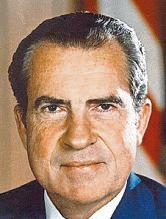
Although grown-ups are supposed to shield children from scandal, my parents didn’t bother sending me out of the room as news of the Watergate cover-up forced President Richard Nixon from office 50 summers ago this month —on Aug. 9, 1974. Iwas only 10 years old,not likely to grasp what was happening, anyway.The older people around me didn’tseem to understand Watergate much better than Idid. Life had changed for us the summer before as the U.S. Senate held televised Watergate hearings from May through August 1973. Lawmakers wanted to learn what Nixon knew about abreak-in at the headquarters of the Democratic National Committee in the Watergate building in Washington. Both of my grandmothers, who fretted about having their afternoon soap operas preempted by the hearings, weren’tasriveted by questions of constitutional order as the senators who droned through our days. Those long Louisiana afternoons of my childhood nowfelt evenlonger Watergate jumbled my routines, too. Summer for me had meant late afternoon matinees on the television, which usually broadcast monster flicks like “Frankenstein” or “The Invisible Man.” Instead, the most ominous part of my summerwas testimony by Nixon associates John Dean and Alexander Butterfield. The tone of the hearings, which combined scolding homilies and the narrow parsingoffact, reminded me of school, adrudgery that summer was supposed to relieve. In those days before 24-hour cable news, we didn’texpect the world to sit in our living rooms from dawn to dusk Except for assassinations and moon landings, current events confined themselves to the newspapers and broadcastsat the top and bottom of the day But Watergate made us feel as if the news had spilled its banks somehow,flooding every hour with urgency With little but Watergate on TV all summer,Iescaped outside —turning over rocks, playing with the dog, dousing dragonflies with my waterpistol. Itrace my interest in the outdoors to that strange season when adrought of decent television programming nudged me to think about trees, birds, and grass instead. One August afternoon in 1974, Icame inside
ä See AT RANDOM, page 2G
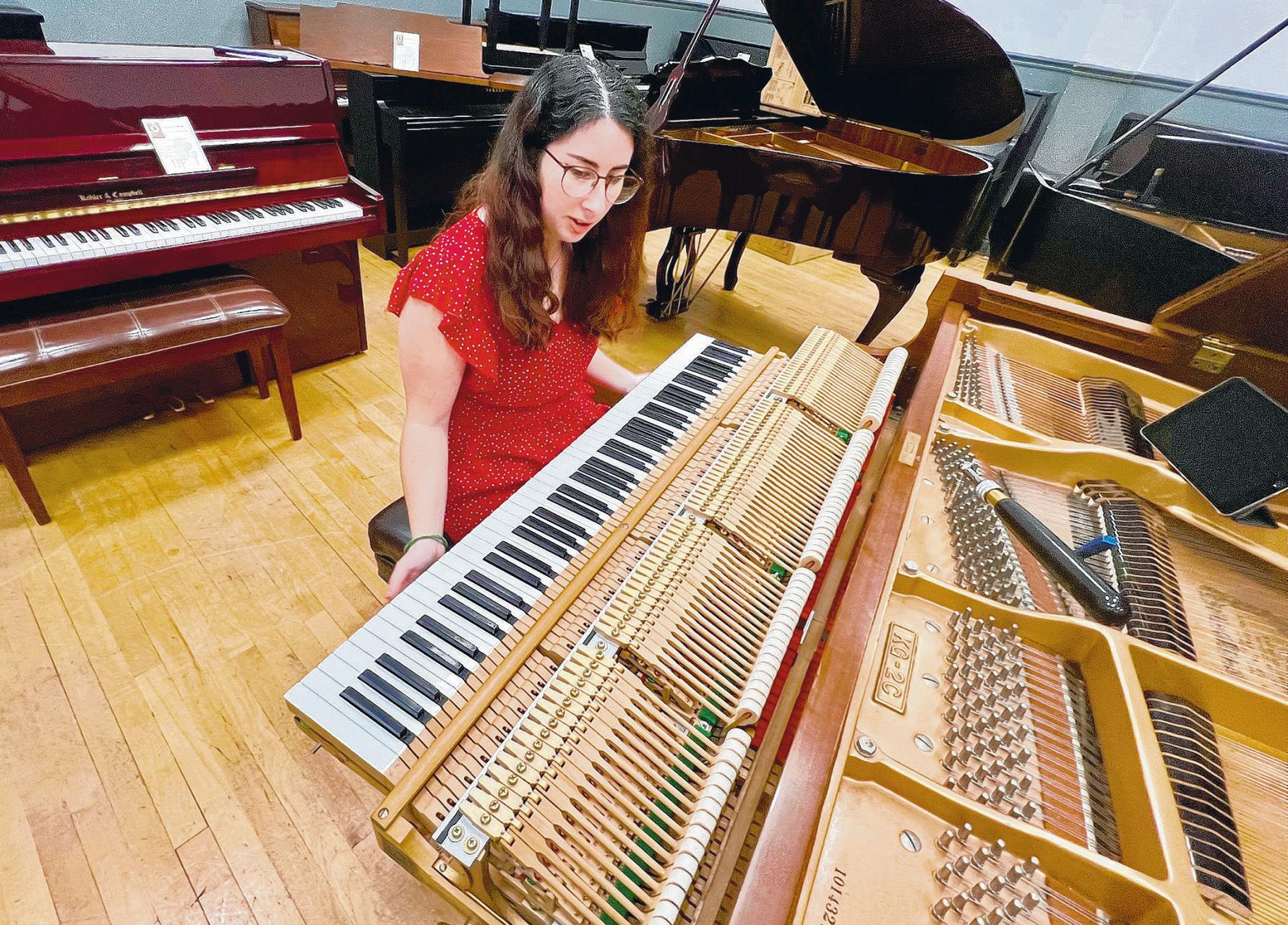

From lifting keyboardsto finding NicolasCage, pianotuning is neverboring forRebecca Rumfellow
BY ROBIN MILLER Staff writer
Most people do a double take when Rebecca Rumfellow sits down at their pianos. Why?
Well,piano tuners aren’t usually 26-year-old women. That’s not apolitically incorrect statement, it’sa fact. Piano tuners usually are men These days, they’re men who are nearing retirement.
New Iberia piano tuner Preston Hebert confirms this fact.Heis 80 and is in semi retirement in the Acadianaarea.
Thetunersheknows are, of course, younger than him by 20 years, which places them in their 60s.
“Thereare five piano tunersin theAcadiana area, andtheykeep busy,” he said. “But the youngest ones Iknow are aman in his early 60s, another in his 60s and my cousin —who travels from Acadianato Mississippi to tune pianos, and he’s also in his 60s.”
So when Rumfellow expressed interest in learning the trade, O’Neill’sMusic House’saffiliated piano tuners jumped at the chance to teach her
“I’ve been doing this two years, but I’mreally still in training,” Rumfellow said.

STAFFPHOTOSBYROBIN MILLER
ABOVE: Rebecca Rumfellowuses atuning hammer to tighten or loosen piano wires when tuning apiano. The tuner on the iPad gauges whether or not the strings are in tune. TOP: Rumfellow, a26-year-oldpiano technician at O’Neill’sMusic House, removesthe action board from a baby grand piano.
That’sher story.Clients see it differently.Oncetheyinvitea piano tunertoworkonthe instruments in their homes, that tuner becomes their tuner
It’s just the natural wayofthings within the business, and now Rumfellow is the tunerfor quitea few pianoowners in the BatonRouge area.
Pianotuningwas neverher lifelong dream, though she’salways loved dabbling in repair work.
“I’ve always enjoyed doing things like this,”Rumfellowsaid.
“I’ve alwaystoldmyself that if I don’tdosomething like repairing
ä See TUNING, page 2G
This isn’tsomething that women my ageusually go into. They were in need of someone to work withthem,and they appreciated that someone younger wanted to learn.”
REBECCA RUMFELLOW,piano tech
The U.S. Patent Office’s blueprint for Charles Frederick Page’s airship. Page applied for the patent in 1903 and received it in 1906. The patent was granted months before theWright Brothers received their patent for the Kitty Hawk
PROVIDED PHOTOBY MICHAEL WYNNE
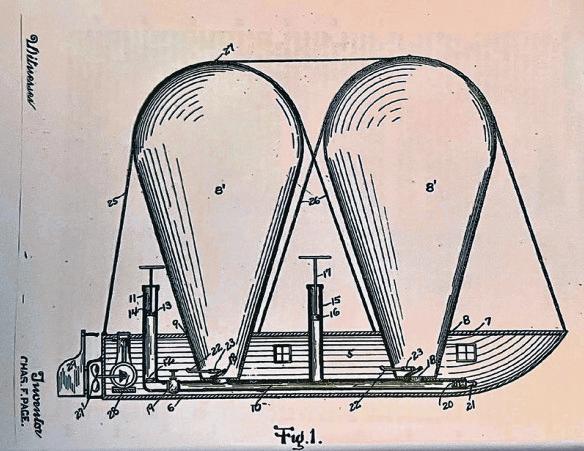
BY ROBIN MILLER Staff writer

The Wright Brothers are known as history’sflying pioneers, thefirst to invent,build and fly the world’sfirst successful airplane. The legendary testflight of their plane, called theWright Flyer,took place on Dec. 17, 1903, at Kitty Hawk, North Carolina. These days, that same plane hangs from therafters of the Smithsonian Institution’s
National Air and Space Museum in Washington, D.C.’s, National Mall. What you won’tsee in that samemuseum is Charles Frederick Page’sairship. The Black inventor applied forapatent eight months before the Wright brothers took flight. Butwhy isn’titthere? Well, that’spart of the question posed by Abigail Miller,ofSlaughter Miller noticed adisplay about

Page in the Louis Armstrong NewOrleans International Airport in NewOrleans. She was
Miller said. “Why didn’this invention receive more attention? And what happened to it?”
Well, first of all, Michael Wynne said, note the year: 1903. Page was African American, andthe JimCrow era was alive andwell in the United States.
“Charles Frederick Pagewas an African American born in 1864,” the Pineville historian said. “There is no census record with his name on it, but he was born in either Rapides or Caddo parish. He wasactually born enslaved.” He eventually married his wife, Ida Kelso, in 1880. The couple settled in Pineville, where the couple raised 13 children He dug coal for aliving in Pineville, and by the 1890s, according to an interview with his daughter in The Alexandria Daily Town Talk in the 1930s, he saw amosquitohawk flying, and he said to himself, ‘If amosquito hawk can fly,Ican fly,’”Wynne said. “Hebuilt atwo-story,wooden house in Pineville.”
Astate historical marker indicates the location of his home on what is now La. 28 East in Pineville —and it was there that he invented an airship.
“It was more of aballoon type plane, but it’snow being heralded in amajor exhibit in the Black Inventors Hall of Fame in Wharton, New Jersey,” said Wynne, who self published the book,“Charles Frederick Page and Leo Ortego: Heroes in the Birth of Aviation in America” in 2022. “Thisisthe story of aBlack man who patented aversion of the airplane before the Wright Brothers.” Wynne also was the catalyst behind the unveiling of thehistorical marker in Pineville.
The Louisiana State Museum and the Louisiana CivilRights Museum collaborated in aJuly openingofanexhibit commemorating Page’sachievement, titled “Pioneer Skies: From Freedom to Flight, the History of Charles Frederick Page,” near the baggage claim at the Louis Armstrong New Orleans International Airport.
The exhibit is an overview of the story Wynne documented through newspapers and governmental records in his book, whichalso includes blueprint drawings of the airship.
“Page’saircraft was acomplicatedmechanical balloon device that actually had propulsion forward, up and down and forward,” Wynne said. “And he built it in his barn behind his house.”
Again, Page submitted apatent application for his invention months before the WrightBrothers’ Kitty Hawk demonstration.
“Now,these patents tooka long time,” Wynne said. “Page’spatent actually took threeyearstoprocess, but that was normalback then.And the Wright Brothers’ patent took aboutthree years, too. Page built alife-size modelof his aircraft, and The Town Talk interviewed Page aboutit.” Which surprised Wynne, because newspapers didn’toften highlight Black southerners for their accomplishments during Jim Crow
“I think The Town Talk did four lengthy articles on Page,” Wynne said. “And, let’sjust be honest, The Town Talk’shighlighting the accomplishments of aBlack man in the South at that time is worthy amedal. They saw everything andgot the story.So, we have acontemporaneous articleright there on everything, so it wasn’trumor —it was news happening.”
The patent was finallyawarded to Page on April 10, 1906, but in the meantime,Page wanted the world to know about his invention.
“Page sent his aircraft tothe 1904Louisiana PurchaseExposition in St. Louis,”Wynne said
This edition of the World’sFair celebrated, as indicated byits name, the centennial of the Louisiana Purchase
“The Louisiana Purchase was signed in 1803, and it wasnever clear to me why they decided to celebrate the centennial one year later in 1904, but they did,” Wynne said. “And they hadan
Continued from page1G
aeronautic competition in which theprize, which was well documented,was half amillion dollars. It was thetotal prize, and there were variousother prizes that could bewon.So, Page shipped his aircraft to St. Louis, and from there, we don’tknow exactly what happened it.”
All that is known is Page’s airship disappeared,which answers the second part of Miller’s question as to what happened to Page’sinvention:Hesent it to thefair,and it never came back.
EvaPage, Page’sdaughter, later told TheTown Talk that the airship had been stolen.
“It was stolen and destroyed, probably due to theprejudice of theday,” hesaid.“Well, that heavily discouraged Page. He’d gotten one offer for $30,000 for thepatent. Ihavethe actual letter, but he was so discouraged after the airshipwas destroyed that hebasically gave up on it.”
Meanwhile, Page’spatent came through two years later
“This was one of the earliest patents that any Black man had ever gotten,” Wynne said. “It was the first patent on an airship —it was granted one month before the Wright Brothers patent was approved. Again, Page’saircraft was adifferent mechanism, but it was still an amazing accomplishment.”
Now comes themost important question:Though thepatent was approved, did Page’saircraft actually fly?
“According to the family, CharlesFrederick Page did fly it, but the story isbasedonfamily tradition,” Wynn said. “But Irespectfamily tradition, and Ihave no reason to doubt it. Family tradition is not exactly themovie somebody tookof the Wright Brothers flying the Kitty Hawk, but Page’sfamily was there, and they passed down the story.”
Page’sstory doesn’tend there. He moved past theloss of his invention and devoted his life to helpinghis fellow man.
“His life was amazing,” Wynne said. “In 1911, aWhitestudent at Louisiana College—now Louisiana Christian University —was walking down Main Street in Pineville, going across the Murray Street Bridge to gotoEmmanuel Baptist Church. ABlack man took apart of apicket fence andused thewood to kill him androb him. Things were escalatinginto arace riot, but Page helped create agroup of mediators between theWhite and Black people to stop this race war.They met inEmmanuel Baptist Church,the White people and the Black people,the mayor the chief of police, everybody.” Tempers cooled,and the conflict was peacefully resolved.
“Anditwas all duetoPage,” Wynne said. “He also built coffins forpeople who could not afford coffins,and he set up abusiness organization for Black men sotheywouldunderstandhow to set uptheirown businesses. It was the first of its kind in central Louisiana.”
Page also practiced amateur dentistry.
“I knowthatsounds terrible, but it was forpeoplewho could notafford dentistry,” Wynne said.
“And he workedatGreenwood MemorialParkcemetery,where he developednew tools onhandling coffins and digging graves.
He then realizedthatBlack people did not haveacemetery of their own, so he founded Lincoln Memorial Cemetery right off of Melrose Street in Pineville.”
Pagedied at age 73 on Nov 18, 1937. He is buried in Lincoln Cemetery,the samecemetery he founded in Pineville.
TheexhibitonPage and his airship will continuethrough Sept. 30 at the Louis Armstrong New Orleans International Airport with acoinciding satellite exhibit on Pageshowingatthe Louisiana Civil Rights Museum Inaugural Experience in the Hall Aentrance of theNew Orleans
Ernest N. Morial Convention Center in New Orleans
Do you have aquestionabout something in Louisiana that’s gotyou curious?Email your question to curiouslouisiana@ theadvocate.com.Include your name, phone number and the city whereyou live.
thefamiliar rhythmsofnational life. Five decadeslater,Iremember her capacitythat fateful day to be shockedbypolitical turmoil. Civic life hashardened alot since then, and we’renot asshaken by the moral lapsesofour leaders as weused to be —ahalf acentury since Isaw my grandmother weepoverRichard Nixon’sexit, that capacity to be shaken seems the biggest loss of all
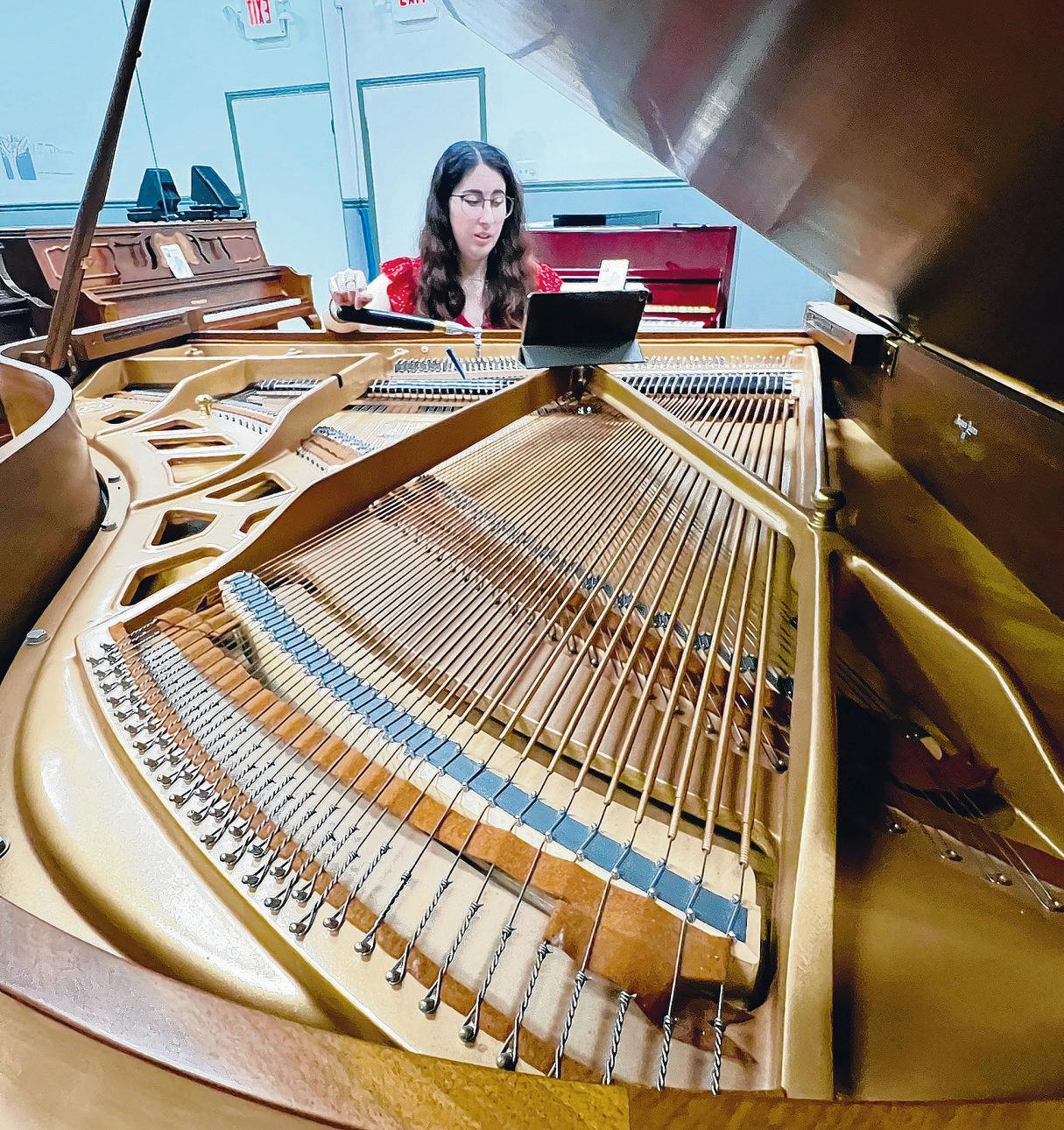
Continued from page1G for adrink of water and sensed that the mood in our den had turned glum. On ourbig Zenith console, Icould see Nixon waving goodbye as he climbed into ahelicopter.Mygrandmother Tucker, hunched in her recliner,fished ahandkerchief from her pocket and dabbed her eyes. What she was mourning,I’d later understand, was abreak in
Email Danny Heitman at danny@dannyheitman.com.
pianos, then Iwould go be acar mechanic. Ijust like to work with my hands, you know? And as ayoung woman, that’snot necessarily always what most people my age are probably doing.”
Still, piano work was never in Rumfellow’slife plan. She just happened to be in the right place at the right time, and that time was during the COVID pandemic.
Rumfellow was laid off from her job transcribing phone calls for people who are deaf when the state’slockdowns were put in place, so Kathy Rumfellow suggested that Rebecca stop by O’Neill’s.
Kathy is Rebecca’smom, who works at the music store’sfront desk while also teaching piano lessons on its pianos. And there are plenty of pianos to be had at O’Neills —uprights, baby grands, player pianos and even the combination traditional and digital pianos called hybrids Many in thebackroom are usedpianosthat need tuning and cleaning, andone of the store’stuners was working on a baby grand thefirst day Rumfellow visited the store.
“So, my mom knew Ineeded something, and she told me to come on to thestore,” Rumfellow said. “She said they needed someone just to answerthe phones and do easy cleanup work in the store. But one day, one of our advanced techs was here, and he had taken apart a whole piano, and he was working on it.”
Rumfellow’smom encouraged her daughter to observe his work in progress.
“She said, ‘Just watch him, you know,tosee if what he’sdoing looks interesting,’” Rumfellow said.
Well she did, and it was. Before long, she was shadowing piano techs, then going solo.
“I liked the idea and over time the technicians said, ‘Why don’t we start training you, and you canbasically start tuning,and you can kind of see if youlike doing this type of work,’”Rumfellow said. “And ever since then, I’ve just been repairing, tuning, cleaning, making them pretty,restorative work.”
Now the pianotechnicians have welcomed Rumfellow into their ranks. That’stheir technicalname, by theway —piano techs.
They’re still called piano tuners by outsiders, but their jobs entailmuch more than mere tuning.Some pianos need major cleanings inside and out, others need repairs.
On this day,Rumfellow’sfocus is on aused baby grand in the store. It’sone of many that customers have sold to the store because it’seither too big for their homesorinherited from adeceased family member and they have no place for it.
Atuning hammer,which is aspecial wrench for tighten-
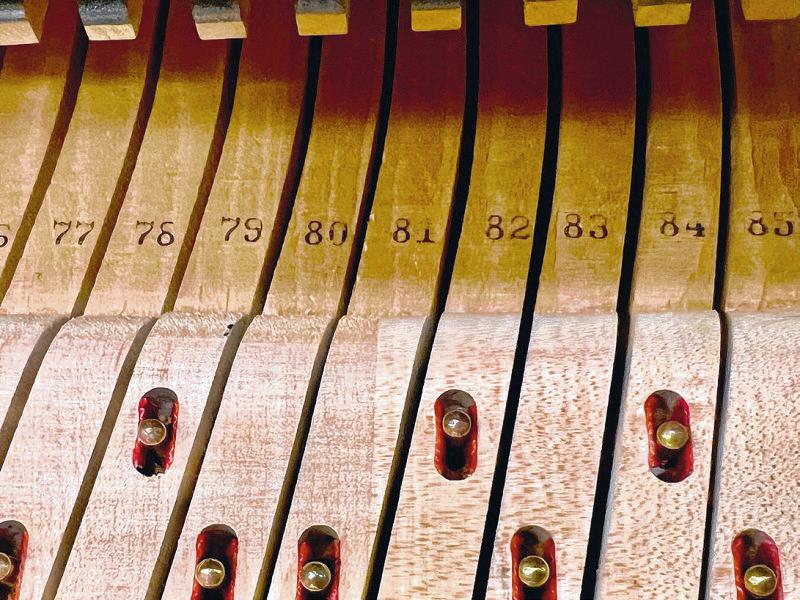
Each keyisnumbered withinapiano’saction board. If Rumfellow has to takethe action board apart, she can use the numbers to reassemble the keys.
ing or loosening strings, is secured atop atuning pin holding strings near middle Cinplace. She removes the fallboard, which covers thekeys when thepiano isn’tbeing played then dislodges the cheekblocks, which secure the keyboard on either side.
This allows foreasy removal of the action board, which includes the keys andthe felt hammers to which they’re connected. She slides the action boardout andbalancesiton her lap while peering inside the piano.
Still, she can’thelpsmiling at this point, because even silent pianos can throw out afew unexpected surprises, some of them scary
“Oh,I’ve screamed when a few insects have crawled out of pianos,” she said, laughing. “Mostly spiders.”
But she keeps the unscary surprises in abox that she calls her treasure chest.
“It’sjunk, andIkeep it in a box, but Ithink of it as treasure,because thesethingstell the stories of the families who owned the pianos,” she said.
Among the treasures are small pictures, pennies, hundreds of stickers and children’stoys from days when a pianomay have served well as aspaceship for tiny action figures orhideaways for LOL Surprise Dolls.
So, how do these toys make their way into the innermost parts of the piano? Well, Rumfellow doesn’thave an answer for that, just as she hasnoidea as to why her most unusual find was lodged inside an upright piano— alarge photograph of Nicolas Cage.
“It’smyfavorite thing I’ve ever found in apiano,” she said.
Right now, along with the tuning hammer,asmall strip of rubber called amute and an iPad are the onlyforeign objects in the baby grand. Rumfellow uses themutetodojust that —mute piano strings next to the ones on which she’sworking. Meanwhile, theiPad’sscreen displays atuner.The tunerappears as agraph of sorts, gauging whether strings are sharp or flat. Once strings are loos-
ened or tightenedtothe right consistency,they register as being in tune on screen.
“There are two strings for this note, and thegoal is to make it sound like one note,” Rumfellow said. “If thetwo strings aren’tintune with each other,itcreates awave in the sound. Icouldn’thear it at first, but the technicians told me that it would be like muscle memory after awhile. They said Iwould get in the zone and automatically hear it, and they were right.”
Rumfellow didn’texactly call herself amusician when she came into the job. She writes songs, and she transposes her music by ear on the digital keyboard in her home.
“I can play,but I’m not really good at reading music,” Rumfellow said.
Her mom is helping her with that, but the subject of her digital keyboard brings up another point. People are opting forthe digital instruments, because they don’ttake up much room, and they’re travel-friendly for musicians.
Still, Rumfellow is an advocate for real pianos.
She says that no two pianos arethe same. Each has its own personality traits,muchlikethe musicians playing them.
For Rumfellow,it’sfun to discover and tailor her care to accommodate those traits.
“This isn’tsomething that women my age usually go into,” she said. “They were in need of someone to work withthem, and theyappreciated that someone younger wanted to learn.”
The more Rumfellow does the job, the more she realizes how perfect afititisfor her
“Being awoman and being young, it’slike, who gets to do this?” she said. “It’ssomething that’ssosimple and fun, and you get to learn, so your brain stays active and your body’s staying active. It’shard work, anditcan getphysicallyintense sometimes just cleaning for a few hours, but it’sdefinitely a worthwhile position.”
After running into Nicolas Cage, who knows what other surprises await?
Email Robin Miller at romiller@theadvocate.com.
‘Ithas
BY EVAJACOB BARKOFF
Contributing writer
RomaineMcCarthy still remembers the first year she attended the Trinity EducationalEnrichment Program on the campus of Trinity Episcopal Church andSchool in NewOrleans and met programdirector Alvin Edinburgh.
“The very first thing Inoticed was how Alvininteracted with everyone, talking to us individually and gettingtoknowus,”said McCarthy,the program’s assistant director,who is also the upper school learning specialist at Isidore Newman School. “I was about 9years old back then, and Iwas very shy
“What Alvin did for me, and Iamsure forothers as well, is what he is still doing now —showing agenuine interest in each child, encouragingyou to find your own voice.”
“What Iremember about Alvin was that he was firm but not in amean way,” added MiaWallace, whoalso attended the program. “Alvin has an endearing way of showing how he cares and lovesyou as his own.
“The message Igot from him was you can be anything you want to be and that has stayed with me my whole life.”
‘Ithas been ablessing.’
After 46 years, Edinburgh, 89, retired in July
“It’shard for me to explain what this program means to me,” Edinburgh said. “It has been ablessing to have worked with so many generations of children.”
The program, founded in 1966, offersa six-week,tuition-free summer program for economically disadvan-
taged youngsters. It serves two age groups —anearly childhood groupfor pre-K to second grade students, anda middle school group of risingfifth and sixth graders.
Ashley Eastham is communicationsdirector for Trinity.She said about 80 youngsters participated in the program this year
“Thisisnot aprogram anyonecan applyto,”Eastham said. “Campers are identified and recommended for TEEP by their school principalsand teachers
Thefamilyiscontacted, and boththe family and the child are interviewed together before the program begins.”
Edinburgh, who began at the program teaching a drama coursebefore being named director,said atypical daybeginsassoon as the participants arrive.
“From the very first day they get here, Igreet them with afirm handshake every morning and askthem in return to make eye contact with me,” Edinburgh said. “It’saway of teaching goodmanners when you meetsomeone. Afterthat, the kids have agood breakfast while Ispeaktothem, offering apositive message to start the day.
“Then theymove ontothe academic part of the programinreading, science and math. And after lunch, thekids can participate in activities they are interested in such as dance, art and music.
“There are five core values that we instill in each personwhichwecall‘the five Rs’ —respect,responsibility,reciprocity, restraint and redemption. These are values that will help them as they grow older.”

Funand learning
In additiontothe academicsand creative arts experience, participants go on field trips to local attractions including theChildren’sMuseum, the Global Wildlife Center in Folsom and the LandO’Pines in Covington for aday of hiking, tubing and barbecue.
“Many of thekids have never had an opportunity to participateand enjoy this kind of fun,” saidEdinburgh, who taught for 39 years in New Orleanspublic schools. “Several of the parents also participate in thefield trips,giving them achanceaswelltohavefun along with theirchildren.”
The program is supported by members of Trinity church andseveral local
organizations, including the Harry HowardIII Foundation, the New Orleans Jazzand Heritage Foundation, theGaudet Community GrantProgram, the VincentMemorial Legacy Fund, Women of the Church and the Gladys Gay LeBreton Trinity Educational Enrichment ProgramEndowmentFund.
In addition to attending the program as achild, Jason Coleman has been a volunteer,counselor,head counselorand donor. He nowserves as its board chair
“The twothingsAlvin has represented in TEEP are stabilityand excellence,” Coleman said. “Weare already planning his 90th birthday and establishing
in perpetuity an endowment so hislegacycan enrich TEEP forever.”
Nurturingself-confidence
Wallace’sdaughter,Kennedy,participated in the program this summer for the first time.
“Before she began TEEP, Inoticed Kennedy was lacking alittle in self-confidence,”Wallace said. “But afterthe first week, she couldn’tstop talking about all the classes, especially drawing, whichisher happy place. Icould see Kennedy’sconfidencelevel increase. She has blossomed and become more independent, too.
“The resources that were available to me at TEEP opened anew world of pos-
sibilities. And the ‘Five Rs’ that Alvin instilled in all of us continuestolive in my heart today.”
With his retirement imminent, Edinburgh said he plans to relax,listento moremusic andtravel.He said what he will miss most will be “the kids and the community of Trinity.”
“TobeapartofTEEP, youmustbecommitted to it andshowlovetoall the kids,” Edinburgh said. “Love is an action word, so you must put that love into each child you meet by talkingtothemand listening to what they have to say “I hope Ihave been apositive influence in the lives of these children. Being here has been alabor of love.”


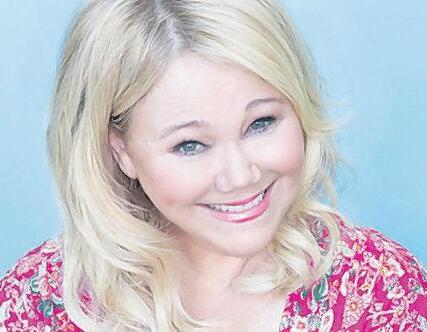




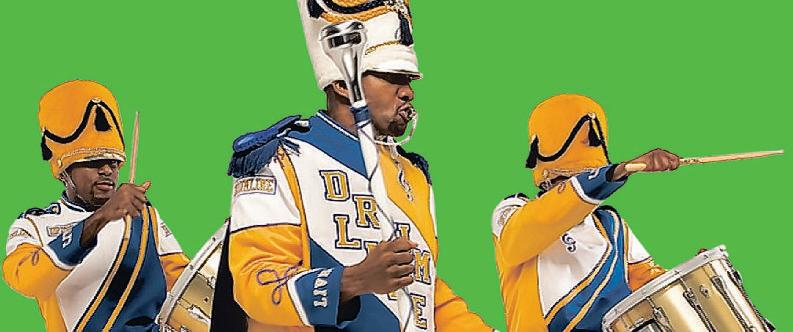
























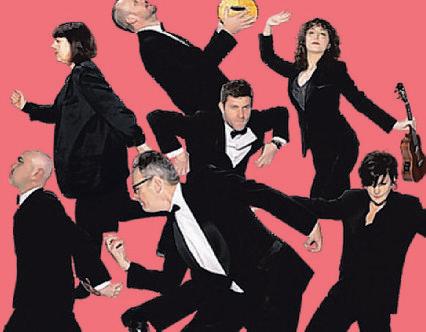

We use theincrediblepowerofour audience to executeadvertisingand marketing campaigns with aclear mindset –results. If we don’t achieve results, we don’t keep our clients.

You’relucky to have onegreat brand. Thankstoacommitment to Louisiana anda commitment to local, we have several.
Andgreat brands bringgreat readers
163MILLION TOT AL USERS
810,000 PR INT READERS
We’recommittedtolong-term success when manyofour peersare retreating. It takes innovation and initiativeacross all ourplatforms andall our teams We’reherefor apurpose. Forour readers. Forour clients. ForLouisiana